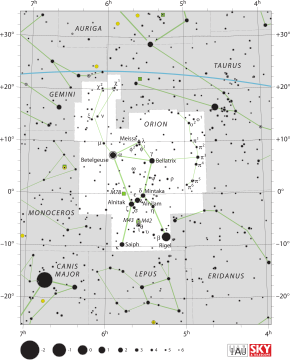
Back Jagter (sterrebeeld) Afrikaans الجبار (كوكبة) Arabic اورايون ARZ কালপুৰুষ (তাৰকামণ্ডলী) Assamese Orión (constelación) AST Orion (bürc) Azerbaijani Орион (йондоҙлоҡ) Bashkir Septīni Šėinpjuovē BAT-SMG Арыён (сузор’е) Byelorussian Арыён (сузор’е) BE-X-OLD
| Constellation | |
 | |
| Abbreviation | Ori |
|---|---|
| Genitive | Orionis |
| Pronunciation | /ɒˈraɪ.ən/ |
| Symbolism | Orion, the Hunter |
| Right ascension | 5h |
| Declination | +5° |
| Quadrant | NQ1 |
| Area | 594 sq. deg. (26th) |
| Main stars | 7 |
| Bayer/Flamsteed stars | 81 |
| Stars with planets | 10 |
| Stars brighter than 3.00m | 8 |
| Stars within 10.00 pc (32.62 ly) | 8 |
| Brightest star | Rigel (β Ori) (0.12m) |
| Messier objects | 3 |
| Meteor showers | Orionids Chi Orionids |
| Bordering constellations | Gemini Taurus Eridanus Lepus Monoceros |
| Visible at latitudes between +85° and −75°. Best visible at 21:00 (9 p.m.) during the month of January.  | |
Orion is a constellation which is visible from most parts of the world. As well as being one of the 88 modern constellations, it was one of the 48 constellations listed by the 2nd-century astronomer Ptolemy. It is named for a hunter in Greek mythology.
In the Northern Hemisphere, Orion is most prominent during winter evenings, as are five other constellations that have stars in the Winter Hexagon asterism. Orion's two brightest stars, Rigel (β) and Betelgeuse (α), are both among the brightest stars in the night sky; both are supergiants and slightly variable. There are a further six stars brighter than magnitude 3.0, including three making the short straight line of the Orion's Belt asterism. Orion also hosts the radiant of the annual Orionids, the strongest meteor shower associated with Halley's Comet, and the Orion Nebula, one of the brightest nebulae in the sky.
© MMXXIII Rich X Search. We shall prevail. All rights reserved. Rich X Search